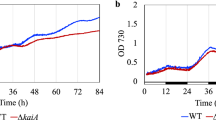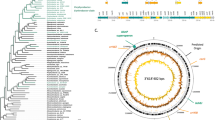Abstract
All oxygen levels are detrimental to the nitrogenase activity ofSynechococcus RF-1 cells. In continuous light, cultures maintain a high dissolved oxygen concentration and a continuous but usually low rate of nitrogenase activity.
Cultures adapted to a light-dark regimen will reduce acetylene almost exclusively during the dark periods. When switched to continuous light, they continue to exhibit a diurnal rhythm in nitrogenase activity. While in continuous light, each upsurge of nitrogenase activity coincides with a marked drop in the net oxygen production rate; this drop is due largely to a concomitant increase in the dark respiration rate of the culture.
The endogenous nitrogenase activity rhythm can be induced in continuous light by periodically lowering the oxygen concentration of the culture by either bubbling nitrogen through it or by treating the culture with 3(3,4-dichlorophenol)-1,1-dimethylurea (DCMU or diuron).
Similar content being viewed by others
Literature Cited
Brown AH (1953) The effects of light on respiration using isotopically enriched oxygen. Am J Bot 40:719–729
Brown AH, Webster GC (1953) The influence of light on the rate of respiration of the blue-green algaAnabaena. Am J Bot 40:753–758
Gallon JR (1981) The oxygen sensitivity of nitrogenase: a problem for biochemists and micro-organisms. Trans Biochem Sci 6:19–23
Gallon JR, Kurz WGW, La Rue TA (1973) Isocitrate supported nitrogenase activity inGloeocapsa sp LB 795: Can J Microbiol 19:461–465
Gallon JR, Kurz WGW, La Rue TA (1975) The physiology of nitrogen fixation by aGloeocapsa sp. In: Stewart WDP (ed) Nitrogen fixation by free-living micro-organisms. London: Cambridge University Press, pp. 159–173
Grobbelaar N, Huang TC, Lin HY, Chow TJ (1986) Dinitrogen-fixing endogenous rhythm inSynechococcus RF-1. FEMS Microbiol Lett 37:173–177
Hardy RWF, Burns RC, Holsten RD (1973) Applications of the acetylene-ethylene assay for measurement of nitrogen fixation. Soil Biol Biochem 5:47–81
Ho KK, Krogmann DW (1982) Photosynthesis. In: Carr NG, Whitton BA (eds) The biology of cyanobacteria. London: Blackwell, pp. 191–214
Huang TC, Chow TJ (1986) New type of N2-fixing unicellular cyanobacterium (blue-green alga). FEMS Microbiol Lett 36:109–110
Lex M, Silvester WB, Stewart WDP (1972) Photorespiration and nitrogenase activity in the blue-green alga,Anabaena cylindrica. Proc R Soc Lond [B] 180:87–102
Author information
Authors and Affiliations
Rights and permissions
About this article
Cite this article
Grobbelaar, N., Lin, HY. & Huang, TC. Induction of a nitrogenase activity rhythm inSynechococcus and the protection of its nitrogenase against photosynthetic oxygen. Current Microbiology 15, 29–33 (1987). https://doi.org/10.1007/BF01577210
Issue Date:
DOI: https://doi.org/10.1007/BF01577210




